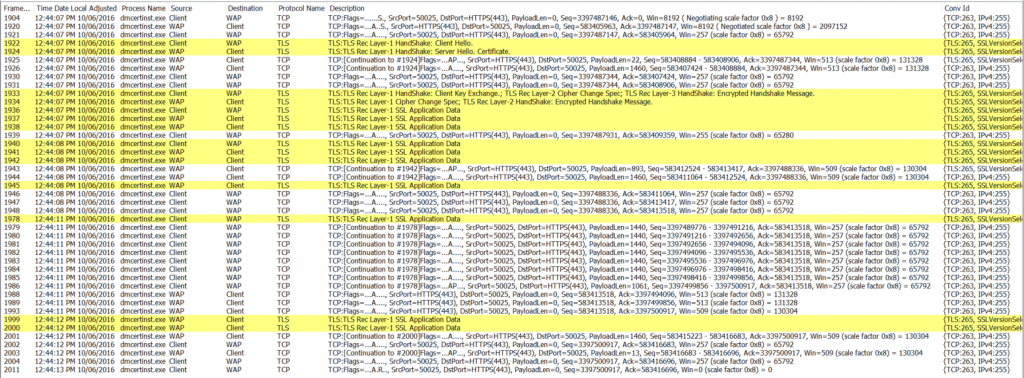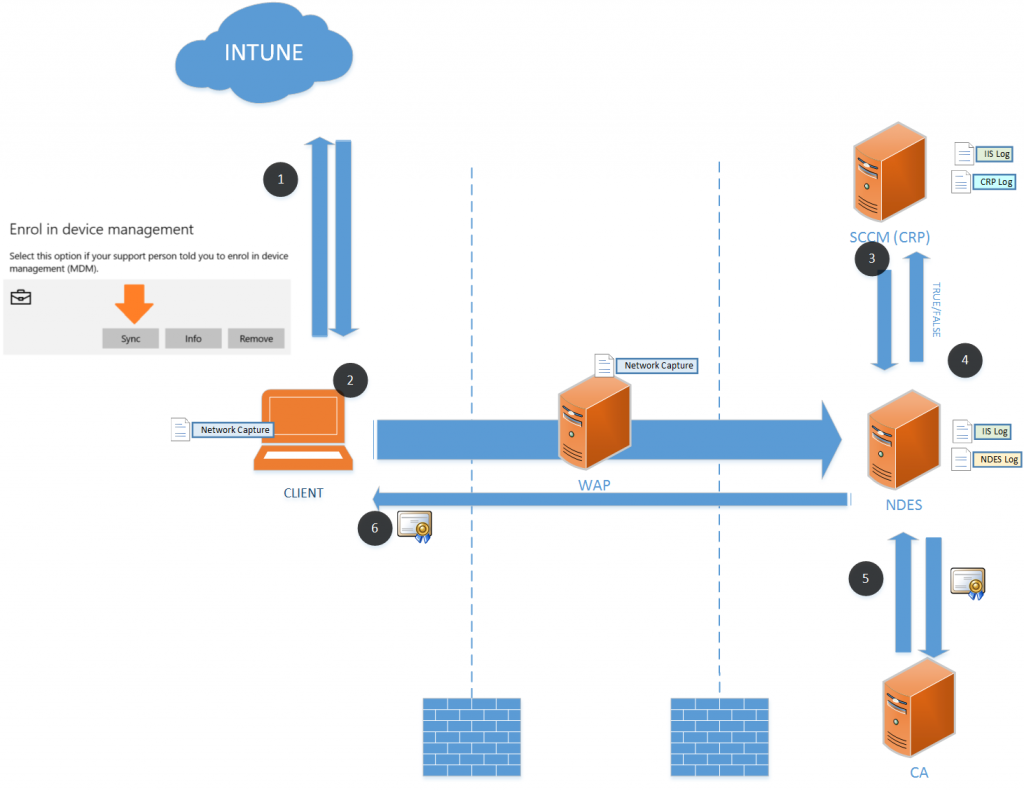SCEP Certificate Deployment - Troubleshooting Reference
The below diagram is a pretty common Intune/SCCM hybrid configuration used to deploy certificates to clients (Win10/Windows Phone/Android/IOS) using the Simple Certificate Enrolment Protocol. If your interested in setting it up - this is a pretty good blog series.
I have had to troubleshoot it a bit lately using different combinations of the logs described here. I've found that it's pretty handy to have a reference of what the logs/traces should look like when working so I know what to look for next time... Hence this post.
Communications Flow – High Level
Communications Flow - Detailed
Manually Trigger the sync for a good repro.
Automatic Synchronisations depends on the client platform:
iOS - Every 15 minutes for 6 hours and then every 6 hours
Android - Every 3 minutes for 15 minutes then every 15 minutes for 2 hours, and then every 8 hours
Windows Phone - Every 5 minutes for 15 minutes then every 15 minutes for 2 hours, and then every 8 hours
Client computer shows 3 separate TCP conversations with the WAP Server (Which it is passing through the Web traffic to the internal NDES Server)
Each TCP conversations shows a successful 3-way handshake, TLS Handshake, then some encrypted SSL traffic.



 NDES SERVER
NDES SERVER 
Check the IIS Log on the NDES Server to make sure each of the Requests made it to NDES. There is a few known issues with this conversation – due to the size of the request from the client. Read this for more details.
#Fields: date time s-ip cs-method cs-uri-stem cs-uri-query s-port cs-username c-ip cs(User-Agent) cs(Referer) sc-status sc-substatus sc-win32-status time-taken
2016-06-10 02:44:06 [NDES-IP Address] GET /certsrv/mscep/mscep.dll/pkiclient.exe operation=GetCACert&message=MDM 443 - [WAP-IP Address]- - 200 0 0 0
2016-06-10 02:44:06 [NDES-IP Address] GET /certsrv/mscep/mscep.dll/pkiclient.exe operation=GetCACaps&message=MDM 443 - [WAP-IP Address]- - 200 0 0 31
2016-06-10 02:44:08 [NDES-IP Address] GET /certsrv/mscep/mscep.dll/pkiclient.exe operation=GetCACaps&message=default 443 - [WAP-IP Address]Mozilla/4.0+(compatible;+Win32;+WinHttp.WinHttpRequest.5) - 200 0 0 13
2016-06-10 02:44:08 [NDES-IP Address] GET /certsrv/mscep/mscep.dll/pkiclient.exe operation=GetCACert&message=default 443 - [WAP-IP Address]Mozilla/4.0+(compatible;+Win32;+WinHttp.WinHttpRequest.5) - 200 0 0 1
2016-06-10 02:44:12 [NDES-IP Address] GET /certsrv/mscep/mscep.dll/pkiclient.exe ... 443 - [WAP-IP Address]Mozilla/4.0+(compatible;+Win32;+WinHttp.WinHttpRequest.5) - 200 0 0 502
Check the NDES Log to ensure NDES is asking the CRP to do Validation:
<![LOG[Calling VerifyRequest ...]LOG]!><time="02:44:11.789+00" date="06-10-2016" component="NDESPlugin" context="" type="1" thread="2900" file="ndesplugin.cpp:646">
<![LOG[Sending request to certificate registration point.]LOG]!><time="02:44:11.789+00" date="06-10-2016" component="NDESPlugin" context="" type="1" thread="2900" file="httprequest.cpp:114">
<![LOG[Verify challenge returns true]LOG]!><time="02:44:12.200+00" date="06-10-2016" component="NDESPlugin" context="" type="1" thread="2900" file="ndesplugin.cpp:834">
<![LOG[Exiting VerifyRequest with 0x0]LOG]!><time="02:44:12.200+00" date="06-10-2016" component="NDESPlugin" context="" type="1" thread="2900" file="ndesplugin.cpp:874">
<![LOG[Calling Notifyrequest ...]LOG]!><time="02:44:12.270+00" date="06-10-2016" component="NDESPlugin" context="" type="1" thread="3088" file="ndesplugin.cpp:904">
<![LOG[Sending request to certificate registration point.]LOG]!><time="02:44:12.270+00" date="06-10-2016" component="NDESPlugin" context="" type="1" thread="3088" file="httprequest.cpp:114">
<![LOG[Exiting Notify with 0x0]LOG]!><time="02:44:12.410+00" date="06-10-2016" component="NDESPlugin" context="" type="1" thread="3088" file="ndesplugin.cpp:1167">
Check IIS Log on the SCCM/CRP Server to make sure it received the Verify Request Message
2016-06-10 02:44:12 [SCCM-IP Address] POST /CMCertificateRegistration/Certificate/VerifyRequest - 443 - [NDES-IP Address] NDES_Plugin - 201 0 0 437 349
2016-06-10 02:44:12 [SCCM-IP Address] POST /CMCertificateRegistration/Certificate/Notify - 443 - [NDES-IP Address] NDES_Plugin - 204 0 0 357 102
Check the CRP Log on the SCCM/CRP Server to make sure the validation occurred:
<![LOG[Reading Template Permission Check from registry.]LOG]!><time="02:44:11.8513964" date="6-10-2016" component="CertificateRegistrationPoint" context="" type="1" thread="238" file="">
<![LOG[Validation Phase 1 started.]LOG]!><time="02:44:11.8513964" date="6-10-2016" component="CertificateRegistrationPoint" context="" type="1" thread="238" file="">
<![LOG[Validation Phase 1 finised with status True.]LOG]!><time="02:44:12.0814310" date="6-10-2016" component="CertificateRegistrationPoint" context="" type="1" thread="238" file="">
<![LOG[Validation Phase 2 started for device and user .]LOG]!><time="02:44:12.0814310" date="6-10-2016" component="CertificateRegistrationPoint" context="" type="1" thread="238" file="">
<![LOG[Validation Phase 2 finished.]LOG]!><time="02:44:12.0824068" date="6-10-2016" component="CertificateRegistrationPoint" context="" type="1" thread="238" file="">
<![LOG[Validation Phase 3 started for device 38fdb94d-db5c-468d-b8d6-37aff538e934 and user 4514c247-96e3-4c6e-9d60-806ac5fa7e2f.]LOG]!><time="02:44:12.0824068" date="6-10-2016" component="CertificateRegistrationPoint" context="" type="1" thread="238" file="">
<![LOG[Get Challenge Parameters from DB using query: Execute CRP_VerifyRequestParameters @vchCertificateRequestID = 'ModelName=ScopeId_DEF1415D-2304-49FD-962C-92B560F126A4/ConfigurationPolicy_82ad9d8e-228e-4048-a598-d8a60c0ab996;Version=1;Hash=-1580759952', @vchDeviceID = '38fdb94d-db5c-468d-b8d6-37aff538e934', @vchUserID = '4514c247-96e3-4c6e-9d60-806ac5fa7e2f', @DeviceType = 1]LOG]!><time="02:44:12.0824068" date="6-10-2016" component="CertificateRegistrationPoint" context="" type="1" thread="238" file="">
<![LOG[Validation Phase 3 finished with status True.]LOG]!><time="02:44:12.1504338" date="6-10-2016" component="CertificateRegistrationPoint" context="" type="1" thread="238" file="">
<![LOG[VerifyRequest Finished with status True]LOG]!><time="02:44:12.1514137" date="6-10-2016" component="CertificateRegistrationPoint" context="" type="1" thread="238" file="">
<![LOG[Notify Started.]LOG]!><time="02:44:12.3315169" date="6-10-2016" component="CertificateRegistrationPoint" context="" type="1" thread="237" file="">
<![LOG[Beginning state message creation...]LOG]!><time="02:44:12.3315169" date="6-10-2016" component="CertificateRegistrationPoint" context="" type="1" thread="237" file="">
<![LOG[Retrieveing the CRP certificate]LOG]!><time="02:44:12.3315169" date="6-10-2016" component="CertificateRegistrationPoint" context="" type="1" thread="237" file="">
<![LOG[Retrieving the GWP or MP certificate.]LOG]!><time="02:44:12.3395154" date="6-10-2016" component="CertificateRegistrationPoint" context="" type="1" thread="237" file="">
<![LOG[Sending Success state message]LOG]!><time="02:44:12.3714356" date="6-10-2016" component="CertificateRegistrationPoint" context="" type="1" thread="237" file="">
<![LOG[StateMessage C:\Program Files\Microsoft Configuration Manager\inboxes\auth\statesys.box\incoming\csq5f2dte2d.SMX is dropped.]LOG]!><time="02:44:12.3714915" date="6-10-2016" component="CertificateRegistrationPoint" context="" type="1" thread="237" file="">
<![LOG[Successfully sent state message]LOG]!><time="02:44:12.3714915" date="6-10-2016" component="CertificateRegistrationPoint" context="" type="1" thread="237" file="">
<![LOG[Notify Finished.]LOG]!><time="02:44:12.3714915" date="6-10-2016" component="CertificateRegistrationPoint" context="" type="1" thread="237" file="">
Check certsrv.msc on the Issuing CA making sure that a certificate has been issued by the NDES Service account (svc_NDES in the screenshot).

 CLIENT
CLIENT
Check that the Certificate store on the device. (Certmgr.msc since this is a USER Certificate).

Log file Locations:
 There are a bunch of ways to capture a network trace (Network Monitor 3.4, Microsoft Message Analyzer or Wireshark). However, my favourite is capturing a trace without installing anything:
There are a bunch of ways to capture a network trace (Network Monitor 3.4, Microsoft Message Analyzer or Wireshark). However, my favourite is capturing a trace without installing anything:
netsh trace capture=yes tracefile=c:\trace.etl
 %systemdrive%\Program Files\Microsoft Configuration Manager\Logs\NDESPlugin.log
%systemdrive%\Program Files\Microsoft Configuration Manager\Logs\NDESPlugin.log





